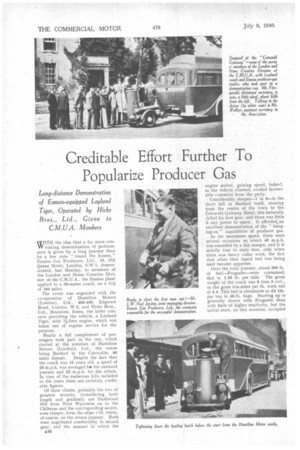Creditable Effort Further To Popularize Producer Gas
Page 18

Page 19

If you've noticed an error in this article please click here to report it so we can fix it.
Long-distance Demonstration of Enness-equipped Leyland Tiger, Operated by Hicks Bros., Ltd., Given to C.M.U.A. Members
WITH the idea that a far more conVV vincing demonstration of performance is given by a long journey than by a few runs " round the houses," Enness Gas Producers, Ltd., 19, Old Queen Street, London, SAVA, demonstrated, last Monday, to members of the London and Home Counties Divisior of the C.M.U.A., the Enness plant applied to a 32-seater coach, on a trip of 160 miles.
The event was organized with the co-operation of Hamilton Motors (London), Ltd,, 466-490, Edgware Road, London, W.2, and Hicks Bros„ Ltd., Braintree, Essex, the latter concern providing the vehicle, a Leyland Tiger, with 7f-litre engine, which was taken out of regular service for the purpose.
Nearly a full complement of passengers took part in the run, which started at the premises of Hamilton Motors (London)', Ltd., the venue being Burford in the Cotswolds, 80 miles distant. Despite the fact that the coach was 10 years old, a speed of 26 m.p.h. was averaged fir the outward journey and 22 m.p.h. for the return. In view of the numerous hills included in the route these are certainly creditable figures.
Of these climbs, probably the two of greatest severity (considering both length and gradient) are Dashwood Hill from West Wycombe on to the Chilterns and the corr!!sponding ascent, even steeper, from the other r:de, taken. of course, on the return journey. Both were negotiated comfortably in second gear, and the manner in which the engine pulled, gaining speed, indeeci, as the vehicle climbed, evoked favourable comment from the party.
Considerably steeper1 in 6—is the short hill in Burford itself, running from the centre of the town to the Cotswold Gateway Hotel; this -naturally Called for first gear, and there was little if any power to spare. It afforded, an excellent demonstration of the " hanging-on " capabilities of producer gas.
As for maximum speed, there were several occasions on which 40 m.p.h. was exceeded by a fair margin, and it is strictly true to state that, only when there was heavy collar work, the fact that other than liquid fuel was being used became apparent.
Over the total journey, about 300 lb. of fuel—Progasite—were consumed; that is, 1.88 lb. per mile. The gross eight of the coach was 8 tons 5 cwt., so the gross ton-miles per lb. work out at 4.4. This fuel is obtainable at £4 16s. per ton in 46-lb. bags. Starting up is generally slower with Progasite than with fuels of higher reactivity, but the initial start, on this occasion, occupied only 2 inins. 20 secs. After a stop of 40 minutes, neither relighting nor the use of petrol were needed, the coach getting away after about 5 minutes' drawing up. A longer stop, however, of just over two hours called for relighting.
Not once, during the day, was petrol used for giving extra power or speed, and no trouble nor hitch of any sort occurred. In our opinion, the general performance was excellent, and with that view we are confident that the operators who experienced it will unanimously concur.
As previously mentioned, the Leyland had been taken off its regular service _tor the demonstration. This was the first day it had missed. Since converted to gas it has covered 3,000 miles on stage-work between Braintree and Witham, a distance of eight miles. The route, we are informed, is a difficult one, including a 1-in-I2 hill, but running has been quite satisfactory and trouble free. Using a mixture of Progasite and Suncole, it has been averaging a consumption of 1.75 lb. per mile, costing 9s. per day as compared with 22s., the former daily cost of petrol. Its daily distance is 80 miles, and it covers each single journey in about 30 minutes, making, on the average, eight stops per mile. No alteration has been made to the compression ratio, but the ignition setting has been advanced 6 degrees. Maintenance operations include cleaning the filters and coolers twice a week, the former operation being effected by shaking out the sisal. Once every fortnight the coke is re-oiled, one quart being employed.
Among the party travelling in the coach were Mr. Walker and Mr. Fitzgerald, of the C.M.U.A., Mr. Hicks and Mr. W. IL Jordan, of Hicks Bros., Ltd., the operator of the coach, Mr. W. N. Jordan and Mr. Gardner of the Enness company, and Mr. Payne of the Hamilton Motors concern.




















































